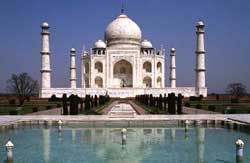DK History: Mughal India
The Mughal Empire, founded in 1526, was the most powerful Islamic state to rule in India. It was at its most prosperous during the 17th century, when fine buildings such as the TAJ MAHAL were constructed.
Table 49. THE MUGHAL EMPIRE
| 1526 | Babur founds Mughal Empire |
| 1556 | Akbar the Great begins reign |
| 1605 | Jahangir becomes emperor |
| 1628 | Shah Jahan comes to power |
| 1659 | Aurangzeb seizes the throne |
| 1675 | Sikhs rise against Mughal rule |
| 1707 | Start of Mughal decline |
| 1857 | Last emperor |
Mughal means “Mongol.” Babur, the Asian invader who founded the empire, was descended from Mongol warlords. Under the Mughal emperors, roads were built, trade prospered, and the arts flourished.
The Mughals governed northern India, and at times their rule extended from Afghanistan in the west to Bengal in the east. The emperor Aurangzeb moved the capital from Agra to Delhi and pushed the empire’s borders far to the south.
The Mughals had to fight against Afghans and many regional Hindu rulers. The early Muslim emperors allowed all kinds of religious worship, but Aurangzeb offended Hindus and caused the Sikhs to rebel. He also clashed fiercely with the west coast kingdom of the Marathas and its ruler, Sivaji. However, it was the growing political power of British traders in India that brought about the final decline and collapse of the Mughal Empire in the 18th century.
The most famous monument of Mughal architecture is the Taj Mahal. It was built in the 17th century by Shah Jahan as a tomb for his beloved wife, Mumtaz-i Mahal, who died in childbirth.
The Taj Mahal was begun in 1632 and completed 22 years later. About 20,000 people were employed, including Asia’s finest craftsmen. Famous for its perfect symmetry, it is exactly as wide as it is high, and the dome is the same height as its façade.

